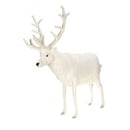Description
5924, REINDEER, WHITE LARGE 48'' Discover the wonders of the Arctic with HANSA Creation USA's exquisite Arctic Animal collection. Immerse yourself in the stunning world of polar bears, graceful penguins, and elusive arctic foxes, all expertly handcrafted to capture the beauty and realism of these remarkable creatures.
FUN FACTS FOR KIDS
- In most populations both the male and the female reindeer grow antlers. Antlers begin to grow on male reindeer in March or April and on female reindeer in May or June. This process is called antlerogenesis. As the antlers grow, they are covered in thick velvet, filled with blood vessels, and spongy in texture. The velvet that covers growing antlers is highly vascularised skin. When the antler growth is fully grown and hardened, the velvet is shed or rubbed off.
- Reindeer hooves adapt to the season: in the summer, when the tundra is soft and wet, the footpads become sponge-like and provide extra traction. In the winter, the pads shrink and tighten, exposing the rim of the hoof, which cuts into the ice and crusted snow to keep reindeer from slipping. This also enables them to dig down (an activity known as "cratering") through the snow to their favorite food, a lichen known as reindeer lichen.
- The knees of many subspecies of reindeer are adapted to produce a clicking sound as they walk or run. The sounds originate in the tendons of the knees and may be audible from several hundred meters away.
- Reindeer can see light with wavelengths as short as 320 nm (i.e. in the ultraviolet range), considerably below the human threshold of 400 nm. It is thought that this ability helps them to survive in the Arctic, because many objects that blend into the landscape in light visible to humans, such as urine and fur, produce sharp contrasts in the ultraviolet. A specific layer of tissue in the eye of Arctic reindeer changes in color from gold in summer to blue in winter to improve their vision during times of continuous darkness, and perhaps enable them to better spot predators.
- Reindeer are ruminants having a four-chambered stomach. They are the only large mammal able to metabolize lichen owing to specialized bacteria and protozoa in their gut; this is a unique adaptation among mammals.
- Normally traveling about 19-55 km (12-34 mi) a day while migrating, the caribou can run at speeds of 60-80 km/h (37-50 mph). Young calves can already outrun an Olympic sprinter when only 1 day old!
- Around the world, public interest in reindeer peaks in the Christmas period. According to folklore, Santa Claus's sleigh is pulled by flying reindeer through the night sky to help deliver gifts to good children on Christmas Eve.
The reindeer also known as the caribou in North America, is a species of deer with circumpolar distribution. Reindeer occur in both migratory and sedentary populations, and their herd sizes vary greatly in different regions. Those living in the tundra are adapted to extreme cold, and some are adapted to long-distance migration. They are unique among deer in that females may have antlers,
Product Dimension: 39.37(L) X 9.84(W) X 47.24(H) 10.92 Lbs.
Each plush masterpiece in our collection is meticulously designed and crafted to bring the Arctic's unique charm to your home, window display or event. Whether you're a nature enthusiast, a collector, or in search of the perfect gift, HANSA Creation USA's Arctic Animal collection offers a touch of the frozen wilderness, ready to inspire and delight all who encounter it.
Payment & Security
Your payment information is processed securely. We do not store credit card details nor have access to your credit card information.




